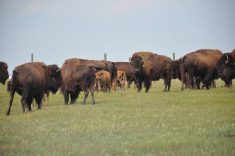BARONS, Alta. – Entrepreneurial Hutterian Brethren is not a
contradiction as far as the artisans at Keho Lake Colony are concerned.
Selling custom-made leather goods, handcrafted oak furniture and metal
work brings in much needed cash to this traditional agrarian group.
More importantly, it gives the young people interesting projects to
maintain the cohesiveness of this colony near Barons in southern
Alberta.
Hutterite colonies are self-sustaining religious sects that build their
own homes and make their own clothing and furniture, as well as produce
Read Also

Trump’s tariffs take their toll on U.S. producers
U.S. farmers say Trump’s tariffs have been devastating for growers in that country.
almost all of their own food. They live a plain lifestyle and have been
in Western Canada since the early 1900s.
At the age of 15, the young men are apprenticed and learn by observing
their elders and performing simple tasks.
“It takes about three to four years before you can see if he is
interested in his work,” said Jake Wurz, who manages the shoe shop.
Besides the workshops, each man on the Keho Lake colony is assigned to
a different area of the farm, whether it is working with the hogs, 300
cow-calf pairs, the 1,000-head feedlot, poultry or the grain side.
But farming has changed, leaving time for other projects.
Rather than languish on the farm during the quiet winter months, this
colony has expanded into a number of money making ventures.
In state of the art workshops, teams of men create custom-made roper’s
boots, saddles, bridles, harness and gloves.
Another shop houses metal workers who weld everything from custom bits
for bridles, garbage cans for schools and giant commercial
dispose-alls. In a nearby workshop, carpenters turn out made-to-order,
solid oak or birch dining suites, beds, cribs, kitchen cabinetry and
chairs.
Shoemaking was the colony’s first major business venture.
“In 1985 we were approached to make shoes for a store. We couldn’t keep
up with the demand. He wanted 30 pairs a week,” said Wurz.
They have since been able to step up production and have the capacity
to make 50 pairs a week if needed.
Keeping regular business hours, he and five other men measure, cut and
stitch about 300 pairs of shoes per year. While their first obligation
is to provide a new pair of shoes for each colony member every year,
their custom shoe business has become a regular business.
Wurz is the main designer and is willing to take on any project a
customer brings. Every colour and type of leather is available, from
cowhide to ostrich.
They specialize in lace up boots with a flat heel, but can make
high-heeled cowboy boots and loafers for women. They also repair shoes.
A custom order takes about three weeks from the time the shoe is fitted
to the completed product.
Wurz learned the trade at his birthplace at Wilson Colony outside of
Coaldale, Alta. When the colony split and moved to Keho Lake in 1981,
he opened the shoe shop.
Craftsmanship has been handed down from one generation to the next.
“Our forefathers brought the trade when they came from Russia,” he said.
Since they went into business they have learned more efficient methods
and bought better tools.
“When we see there is a problem, we reinvent a way to fix it,” said
Rueben Wurz.
No foot is too challenging.
Each shoe is fitted to the customer using plastic moulds. They keep
about 100 of various sizes and they can build up a mould for
hard-to-fit feet.
“If people have wide feet, we can make it fit. For people who can’t
find shoes, we can make them,” said Rueben, who does much of the hand
sewing in the shop. He is also a skilled leather carver and has done
fancy designs for saddles, belts and chaps.
Each shoemaking stage is worked by hand, although there are several
machines for stitching uppers and attaching soles and heels.
They charge $20 per inch, so a 10 inch tall boot is $200.
A year ago, the colony moved into saddle making, tack and other leather
goods. Jake’s brother Dan is in charge of the saddle shop.
Sheepskin from the colony’s flock is used to line the underside of
saddles. Leather is imported from across North America when Jake places
a leather order.
Now the women of the colony have got the business bug and are starting
to sell their handmade bedding.















